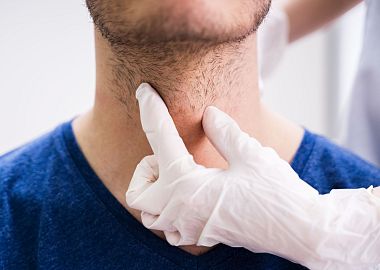
Lumps (Nodule)
General
Lumps in the thyroid gland (called thyroid nodules) are common. About 8% of adults have a perceptible nodule in the thyroid gland. In fact, as many as 25-40% of the adults appear to have one of more nodules in the thyroid gland. In many cases, a lump is only discovered if it becomes visible through the skin. The vast majority of thyroid nodules are benign. Thyroid cancer is a relatively uncommon condition.
Symptoms
A thyroid nodule can cause the following symptoms:
- the feeling that something is stuck in your throat
- difficulty swallowing; the feeling that there is food stuck in your throat, for instance
- shortness of breath or noisy breathing
- hoarseness
- pain in your neck
- swelling in the neck
General symptoms may also occur if the nodule(s) cause an excess or deficiency of thyroid hormone.
Testing and diagnosisThe tests to assess and diagnose a thyroid nodule will almost always consist of a blood test, an ultrasound scan, and often a puncture. Sometimes a special thyroid scan may also be performed.
Blood testsThe thyroid gland produces a number of thyroid hormones that can be measured in the blood. If there is a nodule in the thyroid, the level of these hormones may be elevated, depressed, or normal. The next steps will be worked out depending on the results of the blood test.
UltrasoundAn ultrasound is performed at the radiology department. During the examination you will be asked to lie down on the ultrasound table. A transparent gel will be applied to your neck. The radiologist will then move an ultrasound probe over your neck. The ultrasound device emits sound waves. These sound waves are bounced back through the body and the echoes are picked up by the probe. The thyroid gland is displayed on the monitor. The ultrasound is used to find out what the goiter looks like. The nodule is also measured. This procedure is not painful. You do not need to fast before this procedure.
Puncture biopsyThe nodule must be punctured to determine whether it is benign or malignant. This is called a puncture biopsy. The radiologist will use an ultrasound probe to locate the nodule and then puncture the nodule with a thin needle. This is similar to drawing blood from a vein. No anesthetic will be given for this procedure as it would mean puncturing the skin with two needles. Cells are collected from the nodule through a needle. Sometimes it is not possible to collect enough cells in one go and a second puncture will be necessary. There is a small chance that the puncture may cause bleeding in the neck. If the swelling in the neck increases after the puncture, you should contact the hospital. If you are on blood thinning medication, it is important that you inform the physician of this prior to the puncture. Not all nodules will require a puncture.
Thyroid scanA thyroid scan will usually be performed when thyroid hormone levels are elevated. This is also called a scintigraphy. The thyroid scintigraphy will be performed in the nuclear medicine department, where a radioactive substance will be administered. This substance can be administered in different ways. Sometimes you will be asked to swallow radioactive iodine in the form of a capsule. In this case, you will have to return the next day for the scintigraphy to be performed. This is because the radioactive substance must first be absorbed by the thyroid gland.
You can also have the radioactive substance injected into your bloodstream. The substance will then also need to be absorbed, but this only takes 20 minutes. The scan will determine whether the thyroid nodule is producing hormones.
Your specialist will make a diagnosis once the tests have been completed. This diagnosis will include one of the following three results:
Diagnosis
- Only normal thyroid cells without abnormalities were found.
- The result is inconclusive.
- Cancerous cells were found; you can read more about the treatment under thyroid cancer
There are are various treatment options, which will depend on your diagnosis.
Treatment
- If the nodule is not causing you any problems, you require no further check-ups in the hospital. If you experience new symptoms or the nodule becomes bigger, you should consult your GP again.
- If the benign nodule is causing problems, it can be surgically removed. In this case, the removal of one half of the thyroid gland will often suffice. You can find a detailed description of thyroid surgery in our leaflet.
- Sometimes it is possible to make a troublesome thyroid nodule shrink over the course of several weeks. This is done using a probe and heat, a procedure which is carried out under anesthesia. This procedure is called radiofrequency ablation (RFA) and can currently be carried out at a few of the hospitals in the Thyroid Network (ASz, Maasstad and IJsselland).
- If the nodule is largely filled with fluid, it can be drained and ‘sealed’. This is called sclerotherapy.
Inconclusive result
- An inconclusive result will often be a reason to repeat the tests with an ultrasound and puncture after a few months.
- If a new puncture provides no definitive answer as to whether it is thyroid cancer or not, half of the thyroid gland may be removed so that the nodule can be examined properly. You can find a detailed description of thyroid surgery in our leaflet.
Thyroid cancerYou can read more about the treatment under
thyroid cancer Click
here for the Thyroid Network’s patient leaflet (Dutch) about a thyroid lump (nodule).
Click
here for the patient leaflet (Dutch) on thyroid nodules and goiters published by the Dutch Association for Endocrinology (NVE).
